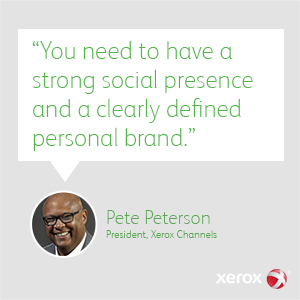 In order to make a sale, you have to provide value to the client. That’s Sales 101. But in my experience, the best way to turn prospects into clients is by building a personal connection. People have to want to do business with you.
In order to make a sale, you have to provide value to the client. That’s Sales 101. But in my experience, the best way to turn prospects into clients is by building a personal connection. People have to want to do business with you.
Networking is the best way to start building personal connections. While social engagement is critical in the digital age, nothing will ever replace a handshake and a smile, and the connection you forge by looking someone in the eye.
Networking is one of the first words to enter your lexicon when you start out in the sales world, but not everyone learns how to do it right.
In talking with sales leaders and business owners around the globe, I’ve learned a lot about what works and what doesn’t, and that’s what I’m bringing you today. Here are some of the top networking mistakes I’ve seen sales teams make – and how you can encourage your teams to do better.
Failing to Follow Up
This one seems like a no-brainer to me, but somehow not everyone got the memo. Sales reps, you absolutely have to follow up after making that initial connection. You can’t count on people to remember your name and what you do when it’s time to buy – especially not at networking-focused events where they may encounter dozens of salespeople.
Not only does failing to follow up show a lack of follow-through from you as a salesperson, remember that there are countless salespeople out there after your lead – and they probably did follow up. In fact, they could be reaching out to your prospect right now.
This advice also applies to networking referrals. The old dating rule about waiting 3 days to call definitely does not apply to sales where the rule of thumb for referrals should be, “the sooner you call, the better.”
Make it easy on yourself by having a go-to strategy in place for following up after every networking event. Consider drafting a simple email template that can be edited easily and quickly; one for following up with a prospect, another for introducing a referral, and so on. And as you’ll see below, following up on social after every event is a must.
Selling a Product, Not Solving a Problem
If you’re in sales, no doubt you’ve seen the TED Talk on “It’s Not What You Do, It’s Why You Do It?” countless times already. But is it shaping the way you network?
Think about the last networking event you attended. My guess is that nearly all of the salespeople around you were, predictably, talking about the products they sell. In an environment like that, it’s easy for your elevator speech to become sales white noise. Instead of introducing yourself and talking about what you do, ask a few questions to find out more about your prospects.
What do they sell? What is their office environment like? What might their pain points be? In doing so you’ll get your own wheels turning so that when the conversation turns to you, you can tell them more than what your product is about: you can explain how your product has value to them.
Read: Understanding SMB Priorities and Selling Solutions to Solve their Pain Points – Small and medium-sized businesses (SMBs) are continually scrutinizing their operations for opportunities to increase efficiency, cut costs and improve bottom-line performance.
I realize there isn’t always time for a conversation of that depth. When that’s the case, you need to be prepared with a short speech that explains in just 1-2 sentences how your business helps solve problems for its customers.
This is also how your online profiles should read. Ask yourself, if you were to explain what you do every day by starting with the phrase, “I help…” what would you say?
Buyers need more nurturing than ever before, so when approaching new prospects remember that “always be helping” is the new “always be closing.”
Read: Why “Always be Helping” is the New “Always be Closing” – Smart marketers and sales representatives recognize that modern buyers require nurturing at every stage and that they must work together to “Always be Helping” buyers.
Confusing Networking with Selling
Let me be clear: engaging in a dialogue about how you help customers alleviate pain points is not the same as making a hard sell. The goal of networking is to meet other professionals who can offer referrals or to find, engage and warm up new prospects. Giving someone the hard sell – especially someone you just met – is a recipe for disaster.
The same is true of not giving people your undivided attention – or worse, focusing solely on your own agenda. Let’s go back to what networking is all about: connection. If your only goal is to hand out as many business cards as possible or collect as many new contact names as you can, you’re working from the wrong mindset. Take the time to get to know people and understand their needs and what they have to offer. You’re looking for opportunities to discover how you can each help one another, which can’t happen if you’re doing the sales equivalent of speed dating.
A recommendation from a trusted source is one of the most powerful sales and marketing techniques available. It’s worth the time it takes to build it.
Staying in Your Comfort Zone
While spending most of your networking hours with people in your own industry may seem like it makes sense, you’re inevitably going to end up moving in the same circles and shaking the same hands over and over again. By thinking outside the box and accepting offers that may not seem logical at the outset, you’ll not only meet new people; you’ll also be introduced to new products, problems, and challenges, forcing you to think creatively about how your business can offer a solution, or how their product or service can help you.
Skipping Social Networking
It’s true that nothing beats a handshake and a smile for making that human connection. But that doesn’t mean you can skip out on social networking. In all likelihood, the first thing your prospects are going to do once that event is over is look for you on social networks, especially professional networks like LinkedIn. You need to have a strong social presence and a clearly defined personal brand. By making more social connections, you can also increase demand for your product. Social connections can be turned into clients with just a few simple tips.
These tips are a great way to start a conversation with your sales reps about how they’re networking efforts are panning out, and where there’s room for improvement. When you’re ready to go a step further, take a look at our 6 Tips for Improving the Performance of Your Sales Teams.
Read: 6 Tips to Improve the Performance of Your Sales Team
In order to succeed businesses must implement tactics that garner better results in a buyer-driven market. Here are 6 things you can do today to improve the performance of your sales team.
 Become a Xerox Channel Partner
Become a Xerox Channel Partner
Ready to become a Xerox Channel Partner? Contact your Xerox account manager or review the Xerox Global Partner Program and apply to become a Xerox channel partner today to find out how we will help grow your business.
Join our Xerox Channel Partners LinkedIn Community
Looking for more marketing tips and insights from Xerox Agents, Concessionaires, and Document Technology partners from across the globe? Join our private Xerox Channel Partners LinkedIn Group.
Share this on Twitter!
Tweet: Expert insights from Xerox’s own Pete Peterson on the top networking mistakes most sales teams make, and how to encourage yours to do better: https://ctt.ac/UQanu+ via @XeroxPartners
Subscribe to the Channel Partner Connection and receive email updates when we publish a new article.[wysija_form id=”1″]



